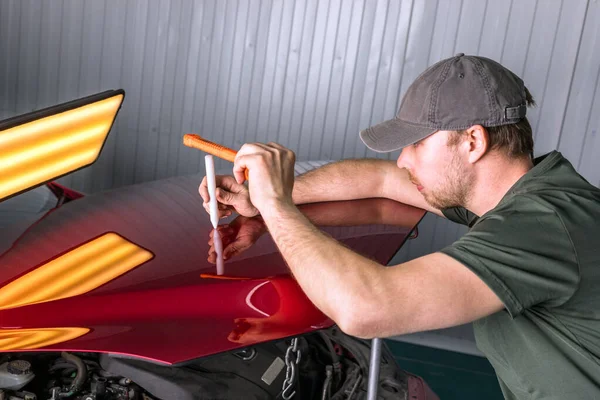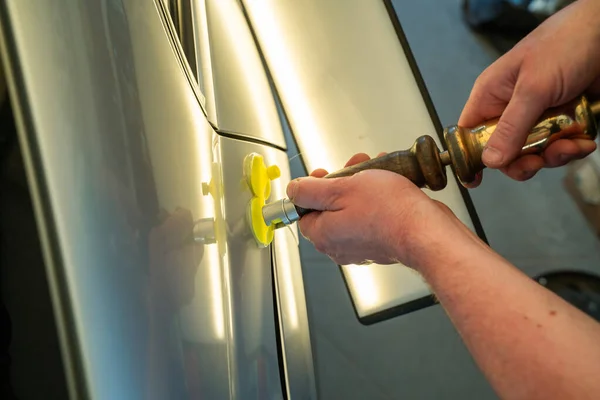Is Paintless Dent Repair Really Worth It? Here’s The Answer
Vehicle upkeep often leads to unavoidable bumps and scratches. These blemishes, whether from an incident in a parking lot or damage caused by hail, can detract from your car's aesthetic appeal and overall value. Traditionally, fixing such issues meant resorting to conventional auto body repair methods, which typically involved significant labor, repainting efforts, and hefty expenses.
Fortunately, the advent of Paintless Dent Repair (PDR) offers vehicle owners a different approach that is faster, more budget-friendly, and better for the environment. But does Paintless Dent Repair truly deliver on its promises? Let’s explore the specifics to uncover the answer.
What is Paintless Dent Repair (PDR)?
How PDR Works
Paintless Dent Repair (PDR) is a method employed to eliminate small dents from a vehicle's surface without requiring any painting or the use of fillers. Rather than sanding down, filling in, and repainting the affected area, skilled technicians utilize specialized instruments to gently push the dent out from behind the panel. This process allows the metal to regain its original form while preserving the vehicle's factory paint job.
This technique works exceptionally well for small to medium-sized dents, like those resulting from hail, door impacts, or slight collisions. Nonetheless, paintless dent repair (PDR) isn't appropriate for every kind of damage. For instance, severe creases, jagged dents, or spots with paint loss may still need conventional auto body repair methods.
The Benefits of PDR

Preserves the Original Paint
A significant benefit of Paintless Dent Repair (PDR) is its ability to maintain the vehicle's factory paint. This original finish is applied under high heat, resulting in a more resilient surface compared to repainted areas. By keeping this factory coating intact, PDR not only sustains the car's aesthetic appeal but also helps retain its resale value. Furthermore, since no repainting occurs, the possibility of color discrepancies is completely avoided.
Faster and More Convenient
Conventional dent repair methods can take several days or even weeks to complete, particularly when repainting is necessary. On the other hand, Paintless Dent Repair offers a significantly faster solution. Small dents can be fixed in a matter of hours, making it an ideal choice for busy vehicle owners who need to minimize their time without their cars.
Cost-Effective
Paintless Dent Repair (PDR) typically costs less than conventional repair techniques since it demands less labor and fewer resources. Unlike traditional methods, PDR eliminates the need for body fillers, sanding, or repainting—factors that can greatly increase repair expenses. For small dents, the price of PDR may be as low as a few hundred dollars, depending on how severe the damage is.
When is Paintless Dent Repair a Good Option?
Types of Dents Suitable for PDR
PDR is most effective for addressing small to medium dents that do not involve any paint damage. This technique is typically used to fix several common types of damage, such as:
- Hail Damage: If your vehicle has sustained small dings and dents from hail, Paintless Dent Repair (PDR) can effectively restore its surface without requiring a new paint job.
- Door Dings: Shallow dents caused by shopping carts, neighboring car doors, and other common parking lot obstacles are ideal candidates for PDR.
- Minor Collision Damage: Light collisions that result in dents but do not harm the paintwork can also be repaired using PDR techniques.

Situations Where PDR is Not Suitable
Although PDR works well for various dents, it isn't suitable for every scenario. When the paint is either cracked or chipped or if the dent is exceptionally deep or situated along a body line, conventional repair techniques might be required. Additionally, if the metal has been stretched or significantly harmed, PDR may fall short of returning the panel to its original state.
Is PDR Environmentally Friendly?
One more factor contributing to the rising popularity of Paintless Dent Repair is its environmentally friendly characteristics. Conventional auto body repairs typically require chemicals like fillers and paint, which emit harmful volatile organic compounds (VOCs) into the atmosphere. Furthermore, the energy-demanding process of repainting vehicles adds to a greater carbon footprint.
Because PDR eliminates the need for painting and harsh chemicals, it presents a more environmentally friendly choice for fixing small dents. This method minimizes the consumption of materials and energy-intensive practices, thereby reducing the ecological footprint associated with auto repairs.
Does PDR Maintain Resale Value?
Car owners who prioritize the resale value of their automobiles should consider PDR as a fantastic solution. When performed properly, this technique eliminates any signs of past damage, preserving the car's original factory appearance. Because it doesn't involve repainting, there’s no chance of color discrepancies or uneven finishes that could turn off prospective buyers.
Cars that have been repaired using conventional methods might show noticeable evidence of touch-ups or filler, which can alert potential buyers or appraisers. On the other hand, Paintless Dent Repair (PDR) provides a flawless restoration that is nearly invisible, aiding in maintaining the vehicle's worth. Contact this site for more information.
How Much Does PDR Cost?
Comparing Costs to Traditional Repair
The price for Paintless Dent Repair (PDR) can differ based on factors such as the dent's size, its position, and how serious the damage is. Generally speaking, PDR is less expensive than conventional body repair techniques. For instance, traditional repairs may exceed $1,000 even for slight dents, whereas PDR usually ranges from $100 to $500 for smaller imperfections, influenced by the technician's expertise and geographical area.
Factors Affecting the Cost of PDR
The price of PDR is affected by a variety of elements, such as:
- Size of the Dent: Bigger dents often take additional time and expertise to fix, leading to higher expenses.
- Location of the Dent: Repairing dents in hard-to-access spots on the vehicle, like the edges of panels or around structurally reinforced sections, might demand additional effort.
- The extent of the Damage: Repairs for dents that are more intricate or deeper might require additional time, which can increase the overall cost of the service.

